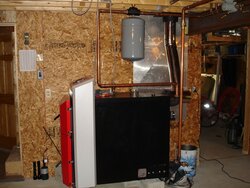 I've read on here about some using TSP for their commissioning fill up. I know this makes a very alcailine solution depending on concentration. Would this flush out bits of oil from the machining, pipe threading, and flux from the copper? Is this left in a system, run hot then flushed, or left in indefinitely? Never heard of doing this until I read it on here, the boiler cleaners available at Sid Harvey seem to be a soap base and not really get this sludgie oil out of a new system as evidenced by removing y-strainers after a couple of years of operation. Seems like a system with a flat plate exchanger would suffer the most form a slight sludge buildup. Should I shoot for a specific pH and maintain it, or am I overthinking the whole thing. Looking at the stacks and thinking it wont be long before I'm burning again, and that Attack has held air pressure for 3 months.......
I've read on here about some using TSP for their commissioning fill up. I know this makes a very alcailine solution depending on concentration. Would this flush out bits of oil from the machining, pipe threading, and flux from the copper? Is this left in a system, run hot then flushed, or left in indefinitely? Never heard of doing this until I read it on here, the boiler cleaners available at Sid Harvey seem to be a soap base and not really get this sludgie oil out of a new system as evidenced by removing y-strainers after a couple of years of operation. Seems like a system with a flat plate exchanger would suffer the most form a slight sludge buildup. Should I shoot for a specific pH and maintain it, or am I overthinking the whole thing. Looking at the stacks and thinking it wont be long before I'm burning again, and that Attack has held air pressure for 3 months.......I asked this on HH with not much responce suprisingly.
PIC of the DPX..... found that the local Amish make some beautiful single wall stainless stove pipe, so I had to get some of that.
TS


 this was all discussed in another thread some time ago. It all worked well when I had the New Yorker WC in place of the Attack, but that was just an expierment to get it all right before I installed a gasser.
this was all discussed in another thread some time ago. It all worked well when I had the New Yorker WC in place of the Attack, but that was just an expierment to get it all right before I installed a gasser.